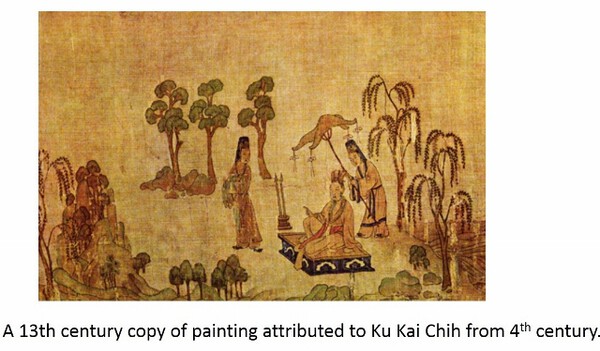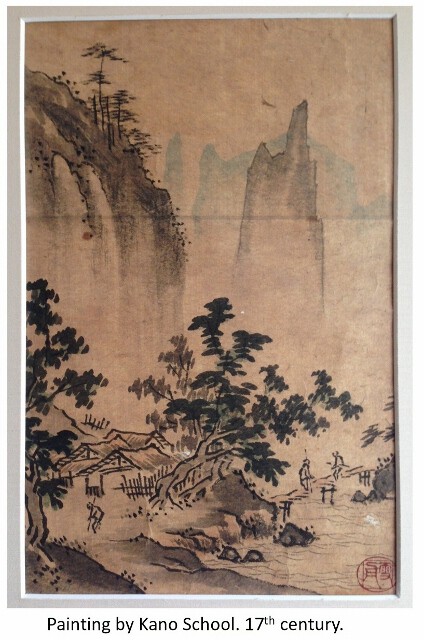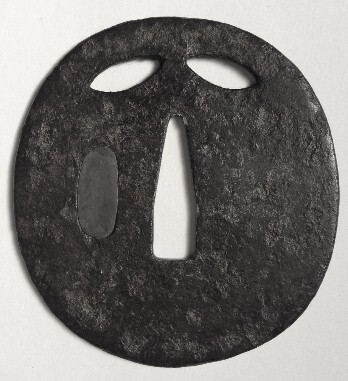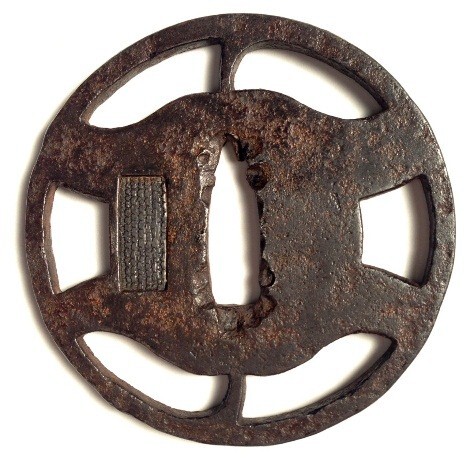-
Posts
1,813 -
Joined
-
Last visited
-
Days Won
8
Content Type
Profiles
Forums
Events
Store
Downloads
Gallery
Everything posted by Henry Wilson
-
Hoan would be nice. The black metal and the motif make me think this. However from the pictures, while the metal seems good, it does not seem to be of the quality associated with Hoan. It could be the monitor though :D The condition looks reasonable which could be an indication of age as opposed to quality and I would say from the general feel that it is mid to early Edo. All things considered, I say a later generation Hoan (from around the 4th). I really hope that it is as you don't see much of them about.
-
Thank you Morita San. The detailed explanation is very educational. I thought it was Ford Hallam's signature.
-
Nice tsuba Christian. The plate looks black, thin and granular, and reminds me of ko tosho and the cut out and motif makes me think kamakura bori. What is your take on it? Thanks for sharing.
-
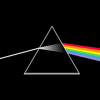
Landscape Paintings 山水画
Henry Wilson replied to Henry Wilson's topic in General Nihonto Related Discussion
Hi Mark Nice paintings. They certainly are sansui and have a very classical look to them. From my limited experience and from the few books I have read (so forgive me if I am way off the mark), I think that the second painting, the mountain scene, has similarities with a famous painting by a Song artist called Li Tang. That is, the mountains in the distance, the way the rocks and shadows are painted, seem to be slightly reminisent of his work. However the color wash in your paintings gives substance to the rocks and landscape and there is an overall sense of realisim. These are all characteristics associated with Ming period paintings. The painting below by a painter called Tang Yin, seems to have a similar arrangement and placement of details as your mountain scene painting. In my opinion, there is a slim chance that the paintings could be from the Ming era (if not modern reproductions) but I think to find out more, you would need to consult an expert. As for the stamp, I can see 日 月 東 but do not have a clue who the artist might be. I hope this helps. -
Sorry Boris. No offense was intended at all. To me both tsuba look similar in design but of course yours is much better. I was hoping to draw attention to how good tsuba should be and was using yours as a stellar example. I should have mentioned that in the post above but I thought it was obvious. Again really sorry and I did not mean to insult anyone.
-
Here is a tsuba with a simialr design for reference: http://www.yamabushiantiques.com/BM%20E ... 0Tsuba.htm
-
Could it be Aizu Shoami? The reason I ask is because it reminds me of this: http://www.finesword.co.jp/sale/kodougu ... 44/544.htm The theme is Tatsutagawa according to the caption. Just a thought.
-
-

Landscape Paintings 山水画
Henry Wilson replied to Henry Wilson's topic in General Nihonto Related Discussion
-

what is definition of waritsuki vs sogetugi, sogekin?
Henry Wilson replied to kaigunair's topic in Tosogu
Hi Junichi If you could provide the kanji, that might be of help. -
What a great thread. I have be meaning to post something on stone arrowheads for a while. Thanks for starting things off. Thanks everyone for the interesting information. I have five stone implements from Japan, 4 arrowheads and a surrated edge cutting tool that I picked up a number of years ago and I have always placed them in the Jomon period. Apart from that I know nothing much about them and consider them to be the earliest type of weaponary produced in Japan, even though they were probably used for hunting and not really designed for fighting. I got them from a very elderly gentleman a number of years ago, who had a small shop near where I live in Mitaka, Tokyo. He had lots of very old antiques, the ones I remember the most are old mirrors, terracota pottery and some Haniwa in great condition. He was kind enough to entertain me for a few hours and he gave me the arrowheads and cutter as a present. My wife and I returned a few months ago but his shop has closed and there is no way of tracing him . A while ago I would frequently come across various arrow heads for sale in antique markets. The link that Brian attached basically says you can buy 5 for 2,000 yen, which seems a bit above the rate I recall. Attached are a few pictures from my collection. The cutter is interesting and according to the elderly gentleman, could have been used as a kind of knife for cutting flesh, or attached to a long stick and used to stab animals. Personally I think it was used to cut as it is quite bulky and the impressions on the sides means it fits well in the hand, and for the serrated ege to be of any use a cutting action would be required. Above all 5 pieces together. Above is the cutter. It is about 4.5 cm long with detail of the serrated edge. Above are two flint-type arrow heads. The left is about 2.5 cm long and the right is about 2 cm. Here are pages from a very detailed website on early Japanese society: http://heritageofjapan.wordpress.com/ http://heritageofjapan.wordpress.com/ju ... e-will-go/ http://heritageofjapan.wordpress.com/ju ... s-toolkit/
-

Landscape Paintings 山水画
Henry Wilson replied to Henry Wilson's topic in General Nihonto Related Discussion
Thank you very much Dirk for the kind words. To tell you the truth I know little about the Choshu School. If you could post a few pictures, that would be very interesting. Also, if any members have any pictures of sansui theme tsuba, why not post them? -
How about the NTHK and NTHK (NPO) shinsa results?
-
I have been researching ink paintings for a while now and here are some notes that I have put together. Landscape Paintings 山水画 In China, from the Han to the Tang periods (206 BC to 906 AD) images of human figures were the main subject of Chinese paintings. By the 9th century the interests of artists started to shift from human figures to nature and by 11th century most of the important paintings were of nature and landscapes with little emphasis or detail of human figures. This represented a shift in social structure in China as figure painting was a product of Confucian ideals and the rise of landscape painting was influenced by Taoist attitudes and ideas as they exceeded Confucian ideas in popularity. The practice of seeking out places of scenic beauty to commune with nature first became popular with Taoists poets and painters, and landscape paintings were used as substitutes for the real thing when necessary. One of the earliest paintings that depicts landscape is a section of the hand scroll called “The Nymph of the River Lo” and is cited to 344-406 AD. A reproduction of a part of it is below: The focus is on the human figures, with the mountains and trees placed all around being out of proportion and appear more as stage props as opposed to actual landscape. During the Song Dynasty (960 – 1280), landscape painting evolved under the hand of Chinese painters such as Li Tang, Ma Yaun, Xia Gui and Ma Lin to name a few. Their paintings became more detailed, organic, spacious, spontaneous and a sense of perspective was developed to give pictures depth as if viewing an open vista and they generally became more realistic. It was this time in the 13th century when landscape painting began to have a strong impact on Japan. Through the patronage of Zen monasteries and associated cultural activities, the shogunate wanted to produce a cultural legacy to rival the Fujiwara of earlier periods in an effort to legitamize their regime. The new Zen monasteries were centres of Chinese learning and many of the monks spent time in China absorbing all they could about Chinese culture, including literature, scholarship and arts. One such missionary to China, during the time of the Ashikaga shogunate, was Sesshu Toyo (雪舟). He was initially a samurai but became a Rinzai Zen Buddhist priest. He was influenced and inspired by Chinese Song Dynasty landscape painting and in 1468 to 1469 he went to Ming China to study, and was quickly recognized as an outstanding painter. Upon returning to Japan, Sesshu established the Unkoku Rin School or the Sesshu School. Although numerous works bear Sesshu's signature or seal, only a few can be attributed to him. Many are either copies or works by his pupils and several painters, including Hasegawa Tohaku, used Sesshu's name for artistic reasons. The above paintings are classic examples of san sui 山水 which means “mountain water” as they typically contain lofty mountains, rocks, rivers, roads, trees, bridges, men and animals with sections divided with empty spaces representing mist or cloud and giving a sense of depth and mysterty. The compositions follow the Buddhist law of Ten Chi Jin 天地人which means that whatever is worthy of contemplation must contain a principal subject followed by complimentary and auxiliary details. This law dictates that everything is below and humbled by the mountain, called TEN 天 or heaven. Next is earth 地, CHI represented by the trees, river and rocks followed by JIN 人representing men and animals. I have been interested in san sui paintings for many years and last summer I was lucky enough to buy the following: It is an ink painting, on paper probably from the mulberry plant, attributed to the Kano School of the mid Edo period and is of a small hamlet, by a river in the mountains. The horizontal line across the the mountains is not a fold, but a join where two papers are connected and there is a red seal in the bottom right hand corner, placed discretely so as not to interfer with the painting, indicating the correct way of viewing the picture is from left to right. The mountain range is painted with a sense of perspective as it disappears into the misty distance. The forward mountain is painted using a techinique called “scattered hemp leaves” giving the impression of wet new foliage and the trees on top are probably maple, judging from the way the leaves are painted. A small hamlet by a wide, shallow river is enclosed by a fence and shrouded in trees and the slight choppiness of the water suggests a waterfall somewhere in the mist. There is a rickety bridge with two men (possibly fishermen) having a passing chat, and another hunched figure walking on a road leading to the left and out off the picture. The river bank and rocks are painted using broad angular lines called “axe stroke” giving a sense of shadow and depth as well as rugginess and power and are a characteristic of Sesshu and the Northern Song School of painting. Three farm houses are arranged in such a way as to suggest that there is more to see and there is a tendency to try to look around the corner and see what else is there. The picture is highlighted with various shades of green giving a feeling of early spring and the emergence of new foliage. The painting is finished with a dot techinique called chobo chobo where rocks and vegetation are highlighted with small dots to heighten and enliven the overall effect and was a techinique favoured by the Kano School. There is a red ink seal reading Sesshu. This painting is not by Sesshu and in my opinon the seal was not applied to deceive, but added as an artistic effect and is a characteristic of the Kano School. Despite the Sesshu seal, I personally feel that this painting is more in the style of Xai Gui, who was one of China’s greatest masters of Song landscape painting and whose style Sesshu was inspired by. His works are typically in ink monochrome, occasionally with a few touches of colour. His style is characterized by short, sharp, angular strokes suggesting rapid execution. The way the trees are painted below are similar in style and composition as the trees in my painting. The theme of sansui is also commonly found in tsuba. The most famous being the ones made by Kaneie of the Momoyama period and by Yasuchika of the Edo period. A thread on sansui motif tsuba alone would be worth investigating. Thanks for reading.
-
Many thanks John. According to my wife it is an old kanji. I will investigate the kanji you have listed and see what I come up with. I might try to get a better impression of it this weekend as it is pretty unclear. Thanks again.
-
Can anyone read this kanji? It is a stone rubbing with a clumsy drawing of what I think the kanji is beside it. Any help would be greatly appreciated. Cheers!
-

Nichiren sect mandala
Henry Wilson replied to John A Stuart's topic in General Nihonto Related Discussion
Hi John Thanks for the reply. I didn't want to split hairs about meaning but I felt it was worth pointing out a difference. The reason being I was not familar with Mandala Gohonzon before reading this thread and the term sumie had me looking for a picture in the scroll. It is very nice by the way. I too have an interest in the Lotus Sutra. Congratulations -

Nichiren sect mandala
Henry Wilson replied to John A Stuart's topic in General Nihonto Related Discussion
Very nice Curran. I hope I am not hiijacking the thread, but here are a few tsuba of mine I would consider Buddhist inspired. They are of lotus petals and lotus leaves. Sorry about the pictures sizes. I have a new computer and can't use it well. By the way, is it accurate to call Mandala Gohonzon sumi-e 墨絵? After all it is not a picture. Would 書道 shodo not be me more appropriate? -
Thanks for sharing the interesting article. The magazine looks very good. Is it possible to subscribe to it?
-
Hi Zanshin 岩国美術館+柏原コレクシン 鍔・縁頭・笄・小柄編
-
For what it is worth, the dragon in the design has 5 toes which would indicate Chinese origin. I have a feeling the stool is a modern made item.
-
Nice tsuba David. I am glad you got something to remember your honeymoon by. On my smartphone, the metal looks very good and makes me think of Owari type metal. Overall the piece reminds me a bit of Nobuie
-
Thank you very much Markus for the follow up. 行年 confused me and I had no time to consult someone.









